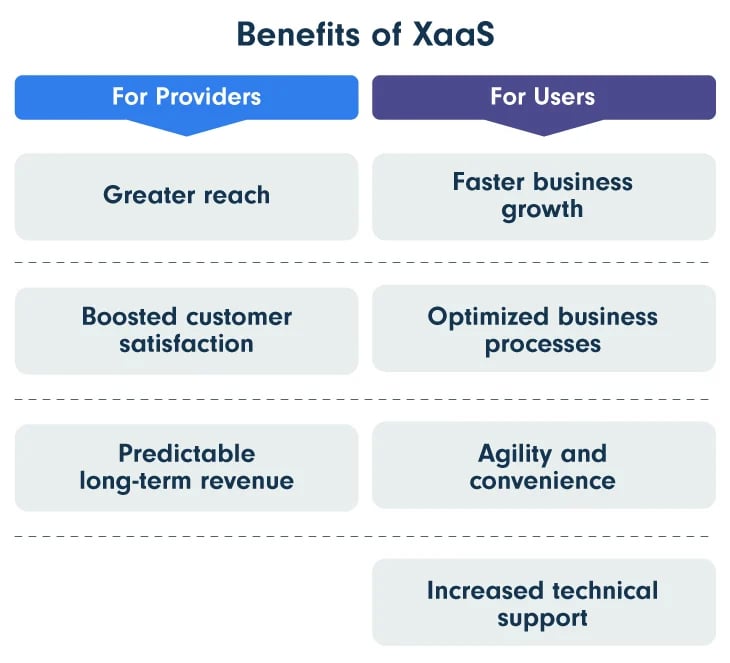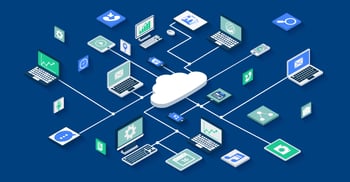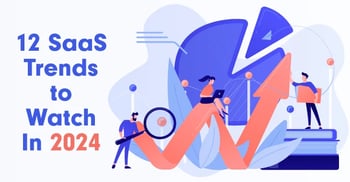XaaS Explained: Revolutionize Your Business with Everything-as-a-Service

Discover the XaaS meaning and how can optimize IT costs by 30% and find out the seven key benefits this cloud computing technology is bringing forward, making top businesses in the tech landscape implement it.
It is expected that the XaaS market will reach $2.4 trillion by 2029. That is truly an impressive number and demonstrates that tech businesses are indeed investing and implementing these tech solutions at a rapid pace.
Not long ago, acquiring software actually meant purchasing a physical product and taking the time to install it on a computer. That has all changed completely, and it all has to do with cloud-based software, revolutionizing how we perceive and use technology. However, as glamorous as everything might sound, finding the correct tech solution for your needs means swimming in a sea of acronyms and deciding which option is the right one for you.
Knowledge and guidance become your lifebuoy.
XaaS (Anything-as-a-Service) is the pinnacle of cloud computing. It’s that full-focused approach that looks at everything your business stands for, from services to infrastructure. Indeed, regardless of your position on the evolution ladder, whether you’re a start-up or an experienced industry player, understanding XaaS is no longer a choice but a necessity.
So, let’s dive in and see what XaaS is actually made of.
What is XaaS?
Just to make things clear from the very beginning: no, XaaS is not a typo. With that out of the way, let’s talk about exactly what XaaS is.
XaaS stands for anything sold as a service. XaaS is a comprehensive concept that includes delivering services, tools, and even games through the cloud, as opposed to traditional on-premises or physical acquisition methods.
Because of this everything as a service perspective, XaaS is really not a new invention. In fact, chances are you already have XaaS-type software in your company’s infrastructure.
Key Definitions in the XaaS Ecosystem
There is no better start in understanding tech concepts than translating acronyms.
SaaS (Software-as-a-Service): Cloud-based solutions that are available via web browsers. Examples include Salesforce, Microsoft 365, and so on.
PaaS (Platform-as-a-Service): Development platforms that enable creators to build apps without managing infrastructure (e.g., Google App Engine).
CaaS (Communications-as-a-Service): Cloud-based communication and collaboration solutions offered on demand.
DaaS (Data-as-a-Service): Data access and management delivered as a service, including virtual desktops.
NaaS (Network-as-a-Service): Network infrastructure and capabilities supplied via subscription mechanisms

Indeed, SaaS, PaaS, and IaaS are widely regarded as the founding fathers of cloud computing. However, XaaS has a broader reach, incorporating any business function and granting as-a-service access.
XaaS Vs. SaaS: What is the difference?
Noticing the impression expansion of the tech world, it’s essential to understand what makes XaaS unique in the cloud computing landscape. With over 31,000 SaaS companies operating globally, it’s simple to see why the diction between SaaS and XaaS in cloud computing is worth exploring:
SaaS (Software-as-a-Service)
- Focus: Cloud-based software applications with predefined functionality
- Scope: Providers manage all IT aspects, including security and updates
- Examples: CRM systems, productivity tools, and specialized business applications.
XaaS (Everything-as-a-Service)
- Focus: Provides all-encompassing technology via cloud-based models
- Scope: Designed for all cloud service types (infrastructure, platforms, software, etc.)
- Flexibility: Users can choose the services they require based on their specific needs.
- Relationship: SaaS is one component of the XaaS landscape.
It’s very important to take a step back and understand that while other cloud computing models might provide specific solutions to problems, XaaS has a holistic approach.
7 Benefits of XaaS
Before we go into the nitty-gritty of XaaS advantages, we need to be clear that this cloud computing model is quite transformative for both business users and providers.

For Service Providers
1. Greater Market Reach
By eliminating the need for physical distribution networks, XaaS allows companies to expand beyond borders faster. They can offer their services without interruption or complex challenges anywhere worldwide, boosting their revenues considerably.
2. Increased Customer Satisfaction
Flexibility and customization solutions represent the key aspects of creating long-lasting and rewarding customer relationships. And that’s what XaaS offers, ultimately leading to higher satisfaction levels. Additionally, businesses can further increase user retention rates through regular updates and dedicated support.
3. Predictable Revenue Streams
One of the most significant benefits of the subscription model is the fact it generates a constant revenue stream. Companies can forecast both their profits and expenses, leading to higher business stability and a great opportunity for future product development and innovation.
For Users:
4. Faster Business Growth
XaaS overcomes traditional scalability limitations by eliminating the requirement for greater infrastructure investments. Businesses may quickly adjust resources up or down to answer demand, reducing the time-to-market for new projects from months to days.
5. Improved Business Operations
By switching to XaaS, service providers can significantly optimize tech operation expenses through improved server maintenance, data center costs, and even IT staff requirements. Combining this benefit with the subscription business model, XaaS brings better resource planning and budget forecasting.
6. Agility and Convenience
XaaS offers rapid access to cutting-edge technologies with no deployment delays. Automatic updates ensure that organizations always have access to the newest features and security upgrades without disruption, allowing them to adapt faster to market developments and consumer needs.
7. Responsive Technical Support
Through dedicated support experts focused on specific areas of the solution and 24/7 available assistance, XaaS providers score multiple points in adequately nurturing customer relationships. By doing so, business users can cut down on in-house IT support, ultimately optimizing maintenance costs and enhancing profitability.
5 XaaS Challenges
While XaaS solutions bring a wide range of business opportunities, there are certain disadvantages one must be aware of.
1. System Optimization
XaaS is a strong support of fast business expansion. However, as you are increasing your market reach, you need to consider key system issues such as data storage, bandwidth optimization, and latency reduction. These need to be improved at the same speed as the growth of your user base. Ignoring them will eventually lead to system slowdowns, and it will impact the quality of the services provided, affecting your brand reputation.
2. Security Threats
Cloud computing solutions like XaaS did provide users with greater accessibility. At the same time, it opened the door to significant security threats. It is imperative that service providers implement solid security measures and comply with data protection regulations to ensure a stable and safe infrastructure.
3. Billing Complexity
Given that businesses value the wholesome approach XaaS solutions have, it is only a matter of time before they stumble into operational complexities. Managing product bundles, subscription lifecycles, billing structures, and various transaction volumes can all become a burden, especially when expanding globally.
4. Outages
With the XaaS model, the user depends entirely on the infrastructure offered by the service provider. In other words, you rely on other systems rather than your own to deliver your product to your customers. If something should go wrong, you have no control over when the issue can be fixed.
5. Hidden Fees
While one of the main benefits of XaaS models is cost efficiency, you must also be mindful of other expenses. For instance, when looking to scale your business, you might have to buy additional licenses or switch to a more costly plan. So, evaluate your present and future needs and choose the option that fits your budget.

3 Real-Life XaaS Examples
XaaS has gained huge popularity, and important names within the eCommerce industry prove this. Let’s explore three of the best-known XaaS platforms.
Amazon Web Services
AWS has adequately implemented XaaS, offering a wide range of services, anything from IaaS, PaaS, and SaaS. Offering more than 200 services, AWS has completely revolutionized the way technology is implemented and managed.
Note: One of the reasons that AWS enjoys so much success is its commitment to innovation and constant product development, proving that the XaaS approach does allow for fast market domination.
Microsoft Azure
Microsoft Azure offers various cloud computing services across the XaaS spectrum. Its connection with Microsoft's software ecosystem provides a seamless experience for enterprises using Microsoft products.
Note: Azure’s success clearly shows that using XaaS infrastructures, product integrations can lead to connected experiences, which translate to profit.
Google Cloud
In the Google Cloud case, the key to success is the pay-as-you-go model behind the XaaS infrastructure, empowering businesses to adequately use the resources they require.
Note: GCP displays how easy it is to bring forward enterprise infrastructure and make it available to businesses of all sizes.
eCommerce Partner
Thrive with the industry's most innovative all-in-one SaaS & Digital Goods solution. From high-performing payment and analytics tools to complete tax management, as well as subscription & billing handling, PayPro Global is ready to scale your SaaS.
Sell your SaaS globally with PayPro Global!
How Can PayPro Global Help?
XaaS is, without a doubt, a strong cloud computing solution. However, building your product around this model makes you subject to a number of billing challenges. Paypro Global simplifies these processes through our unique Merchant of Record model. We take care of the complexity of global billing so you can focus on making the most of what XaaS is ready to offer.
- Subscription Management
PayPro Global manages the complete subscription lifetime, including initial registration, renewals, upgrades, and on-demand transactions. This lowers churn rates and simplifies operational tasks, allowing you to concentrate on product development rather than billing logistics.
To determine your best income approach, experiment with various monetization tactics, models, and techniques. Our pricing engine can handle complicated scenarios, including tiered pricing, usage-based invoicing, and hybrid models that maximize customer value and income potential.
- Payment Security
PayPro Global is a PCI-DSS Level One Certified Partner, with a robust fraud protection architecture in place that drastically lowers the number of fraudulent transaction attempts while preserving seamless user experiences for valid purchases.
We make it possible for XaaS providers to grow internationally without developing specialized legal knowledge by removing the complexities of foreign tax laws and compliance requirements. This enables you to quickly join new markets with the assurance that all compliance needs will be met.
Visit PayPro Global or reach out to find out how we can help take your SaaS global.
Conclusion
XaaS has completely changed the rules of the cloud computing game. It has altered the way we consume and offer technology. It represents the key success drives within the tech landscape. However, as with all things, it cannot be only rainbows and sunshine. There is a more complicated side to XaaS, which you need to understand before choosing to path for business success.
What it’s important to keep in mind is that solutions exist for every problem. And Paypro Global is the evidence that supports this idea. XaaS solutions become a real and solid approach with the help of a payment partner ready to handle all the billing complexities that might arise, leaving you to focus on delivering exceptional customer experiences.
Frequently Asked Questions
What is Everything-as-a-Service (XaaS), and what are its key characteristics?
XaaS is a cloud computing model where any IT function or business capability is delivered as a service over the internet, typically on a subscription basis. Key characteristics include on-demand access, scalability, pay-per-use pricing, and reduced need for on-premises infrastructure.
What are the primary benefits of using XaaS models (for both providers and consumers)?
For providers, XaaS offers expanded market reach, enhanced customer satisfaction, and predictable revenue streams. For users, the benefits include accelerated business growth, optimized operations, increased agility, and enhanced technical support.
What are the main categories of XaaS, and how do they differ (e.g., IaaS, PaaS, SaaS)?
The main categories include: SaaS (Software-as-a-Service): Delivers applications over the internet (e.g., CRM, email). PaaS (Platform-as-a-Service): Provides a platform for developing and deploying applications (e.g., cloud-based development tools). IaaS (Infrastructure-as-a-Service): Offers virtualized computing resources (servers, storage, networks) over the internet. XaaS encompasses all of these, and any other IT function delivered "as a service.
What are some real-world examples of companies successfully using different XaaS models?
Amazon Web Services (AWS), Microsoft Azure, and Google Cloud Platform (GCP) are prime examples, offering a wide range of services across IaaS, PaaS, and SaaS. Many other companies use XaaS for specific functions like communications (CaaS) or data management (DaaS).
What are the potential risks and challenges associated with adopting XaaS?
Providers face challenges in performance optimization, security, and continuous development.
How does XaaS impact traditional IT roles and infrastructure?
XaaS shifts the focus from managing on-premises infrastructure to managing cloud-based services. This requires new skills in cloud architecture, vendor management, and service integration. Traditional IT roles may evolve or become less necessary.
How do pricing models work for different XaaS offerings (e.g., subscription, pay-as-you-go)?
Pricing models vary, but common approaches include a subscription (a fixed fee for access), pay-as-you-go (charged based on actual consumption), or a hybrid model (a combination of both).
What are the key considerations for selecting the right XaaS provider and solution?
Consider the following: Specific needs: What functions do you need to outsource? Provider reputation and reliability: Research their track record and service level agreements (SLAs). Security and compliance: Ensure they meet your industry's requirements. Pricing and cost transparency: Understand the total cost of ownership. Scalability and flexibility: Can the solution adapt to your future needs? Integration: Does it work with your business model?
Ioana Grigorescu
Ioana Grigorescu is PayPro Global's Content Manager, focused on creating strategic writing pieces for SaaS, B2B, and technology companies. With a background that combines Languages and Translation Studies with Political Sciences, she's skilled in analyzing, creating, and communicating impactful content. She excels at developing content strategies, producing diverse marketing materials, and ensuring content effectiveness. Beyond her work, she enjoys exploring design with Figma.
-
1.Explore PayPro Global's Solutions: See how our platform can help you streamline your payment processing and boost revenue.
-
2.Get a Free Consultation: Discuss your specific needs with our experts and discover how we can tailor a solution for you.
-
3.Download our Free Resources: Access valuable guides, checklists, and templates to optimize your online sales.
-
4.Become a Partner: Expand your business by offering PayPro Global's solutions to your clients.
- Businesses may access all IT functions as a service with XaaS.
- Faster business growth and agility are made possible by XaaS, throughh access to cutting-edge technology and automatic updates.
- PayPro Global can assist in overcoming the security, billing, and optimization issues that arise with XaaS.
Get the latest news



